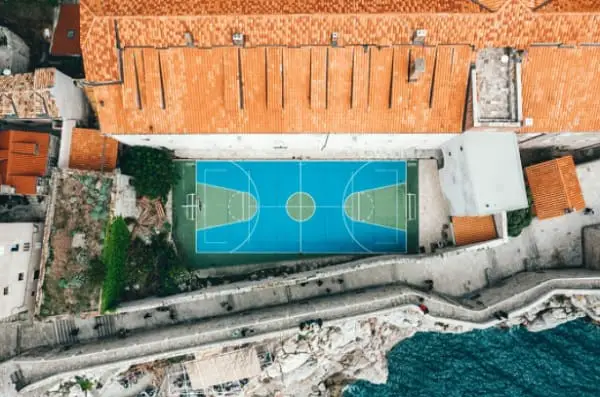
I live near a school and wanted to fly over it to get the right photo, but first I thought I should check if I was allowed to! I did some research and here is what I found.
There are no rules and regulations put in place by the FAA (Federal Aviation Administration) that prevent drone enthusiasts from flying a drone near or over a school. However, there might be ‘No-Fly Zone’ restrictions places over some schools that will prevent drone flights.
Keep reading to find out if the school you want to fly over is in a ‘No-Fly Zones’ and how to fly a drone over a school without getting yourself into any trouble!
How Do You Know If a School Is a No-Fly Zone?
The B4uFly application is an app that was made in order to assist recreational drone users. It was created to help show where pilots can and cannot fly with interactive maps.
This is the FAA’s first mobile application in partnership with Kittyhawk, made to improve the user experience so that recreational flyers know whether it is safe to fly their drone.
Before you fly your drone, use this app to see an interactive map of the area you are in. The map will also identify all the important landmarks in the area, and put a ring around all the No-Fly Zones in the area that you need to stay away from.
If a school is a No-Fly Zone, it will have a ring around it on the app, and you will know to stay far away from that school if you want to stay out of trouble with law enforcement.
What Exactly Is a No-Fly Zone?
A No-Fly Zone(NFZ), or No-Flight Zone is a territory or area that has been established by the FAA, as an area you are not permitted to fly.
It is illegal to fly in or over these areas. They were initially set up to keep civilian aircraft out of war zones and used as a tool to warn an enemy nation not even to think to take to the sky.
After the events of 9/11, the FAA set up various No-Fly Zones all over America in order to protect the American people from the potential of that incident happening again in the future.
Areas that are usually under no fly zones?
There are various types of No-Fly Zones, including permanent No-Fly Zones and temporary No-Fly Zones.
- Governmental buildings, like the White House, are considered permanent No-Fly Zones, and no one is ever allowed to fly near the building.
- Crowded areas are usually placed under a temporary No-Fly Zone in order to protect large crowds attending events.
- Places like Disney World and Sports Stadiums have temporary No-Fly Zones placed around them whenever there is a game being played, and people are filling the stadiums or large crowds are in attendance.
During the day, however, when the stadiums are empty, this flight restriction is lifted, and people are free to fly over these areas.
Because there are no rules and regulations set up by the FAA regarding schools and drones, you would have to look at the next level of authority which is the local State Laws and then the City Laws regarding drones.
Most States, like the FAA, do not have any rules against the flight of drones over schools, however, some states do have rules against drones flying over schools and have set up temporary No-Fly Zones around schools.
Despite their many positive uses, drones can injure people, cause property damage, invade privacy, and distract students. This is why some states have chosen to ban drones from flying over schools. But, how do you know if a school is a No-Fly Zone?
Are Schools Always No-Fly Zones?
There might not be a clear rule that says you cannot fly a drone over a school, however, I would consider a school to be a “sensitive” area.
If you are thinking of flying a drone over a school, you should stop and think if it would be ok if you flew a drone over a hospital or prison, all of which are considered to be critical infrastructure, and should be approached with extreme caution.
Also, it is always a sensitive topic when mixing strangers with cameras and children. If it were up to me, I would make every school a No-Fly Zone for drones during school hours as it would be a lot safer for everyone.
However, schools have some amazing buildings and great open sports fields that would be great for flying drones after school hours or on weekends when the school is empty.
But flying over a school during school hours is definitely not a good idea. There is no FAA rule stating that you are not allowed to fly a drone over a school. However, there is an FAA rule stating that a drone is not allowed to fly over people.
So flying a drone over a school during school hours would be very dangerous as there could be people walking around below, especially since those people could be children.
Flying your drone legally over a school would require the school to not be in a No-Fly Zone, you would need to check all state and city laws, and you would need to make sure that it is not school hours, and the campus is empty.
Can Schools Use Drones?
Drones are small robotic aircraft, and over the past couple of years, they have become increasingly popular in the everyday household.
Drones have huge teaching potential, and will definitely be an asset to be used in the classroom. In fact, a lot of schools and universities are using drones in order to assist as teaching tools in the classroom.
The potential uses for drones in teaching are probably the main reason why drones have not been banned from flying over schools, as you can’t make an area illegal for the public to fly in but legal for school staff and students.
There are a lot of tech-savvy teachers out there that have already started using drones as teaching tools, and so far they have had some promising results!
Drones can be complicated multirotor devices, or just a simple, cheap quadcopter, either way, they can be engaging devices that will make classes more interactive, and relevant for students.
The teachers that have used drones as teaching tools in the classroom have found that drones can help improve students’ orientation and motor skills.
The students end up with a better understanding of the world around them, and the use of drones sparks their curiosity in ways that can be very beneficial!
Uses For Drones in The Classroom
Teaching Social Studies
By allowing students to use drones in an open environment, such as a school field, could inspire students to learn about local geography, cartography, and about the local history of their communities.
Capturing images and videos could be helpful with many of the subjects the students are currently learning.
Teaching Mathematics
Maths is a very tough subject for many kids out there, I know it was for me! But with the use of drones, teachers can give a real-world application to mathematical problems and equations.
Giving an abstract math equation a more practical viewpoint for most students will help them in the long run.
Developing Soft Skills
It is essential to prepare students for an unforeseeable professional future. Students need to be equipped with abilities such as communication, collaborative work, flexibility, self-learning, and empathy.
Drones could be a powerful tool for kids to learn these skills to assist them in the future as they head into the world.
Higher Education
University students can significantly benefit from the introduction of drones into their curriculum.
Journalism, engineering, and even archeology students can significantly benefit from the addition of drones as drones are already being used in these fields professionally.
If you are a teacher and are wanting to use a drone in your class to help put a practical twist on your subject, do your research to find out if you an in fact do this to benefit your students!
